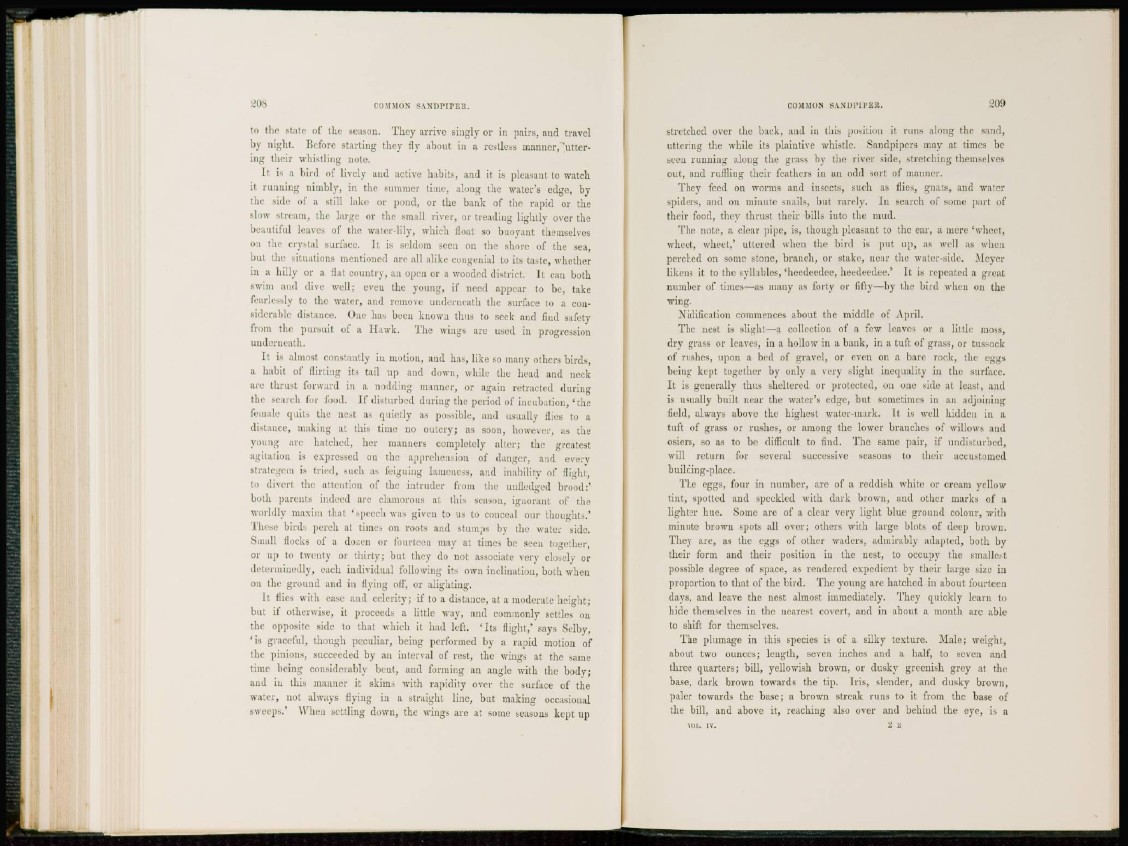
COMMON SANDPIPER.
to the state of the season. They arrive singly or in pairs, and travel
by night. Before starting they fly about in a restless manner, "uttering
their whistling note.
I t is a bird of lively and active habits, and it is pleasant to watch
it running nimbly, in the summer time, along the water's edge, by
the side of a still lake or pond, or the hank of the rapid or the
slov, stream, the large or the small river, or treading lightly over the
beautiful leaves of the water-lily, which float so buoyant themselves
on the crystal surface. It is seldom seen on the shore of the sea,
bin the situations mentioned are all alike congenial to its taste, whether
in a hilly or a flat country, an open or a wooded district. It can both
swim and dive well; even the young, if need appear to be, take
fearlessly to the water, and remove underneath the surface to a considerable
distance. One has been known thus to seek and find safety
from the pursuit of a Hawk. The wings are used in progression
underneath.
I t is almost constantly in motion, and has, like so many others birds,
a habit of flirting its tail up and down, while the head and neck
are thrust forward in a nodding manner, or again retracted during
the search for food. If disturbed during the period of incubation, ' t he
female quits the neat as quietly as possible, and usually flies to a
di-taucc, making a I 1 his time no outcry; as soon, howe\ er, as the
young are hatched, her manners completely alter; the greatest
agitation is expressed on the apprehension of danger, and every
Strategeui is tried, such as feigning lameness, and inability of flight,
to divert the attention of the intruder from the unfledged brood:'
both parents indeed are clamorous at this season, ignorant of the
worldly maxim that 'speech was given to us to conceal our thoughts.'
These bird-- perch at times on roots and stumps by the water side.
Small flocks of a dozen or fourteen may at times be seen together,
or up to twenty or thirty; but they do not associate very closely or
determinedly, each individual following its own inclination, both wdien
on the ground and in flying off, or alighting.
It flies with ease and celerity; if to a distance, at a moderate height;
but if otherwise, it proceeds a little way, and commonly settles on
the opposite side to that which it had left. ' I t s flight,' says Selby,
' i s graceful, though peculiar, being performed by a rapid motion of
the pinions, succeeded by an interval of rest, the wings at the same
time being considerably bent, and forming an angle with the body;
and in this manner it skims with rapidity over the surface of the
water, not always flying in a straight line, but making occasional
sweeps.' When settling down, the wings are at some seasons kept up
COMMON SANDPIPER. 209
stretched over the back, and in this position it runs along the sand,
uttering the while its plaintive whistle. Sandpipers may at times be
seen running along the grass by the river side, stretching themselves
out, and ruffling their feathers in an odd sort of manner.
They feed on worms and insects, such as flies, gnats, and water
spiders, and on minute snails, but rarely. In search of some part of
their food, they thrust their bills into the mud.
The note, a clear pipe, is, though pleasant to the ear, a mere 'whect,
wheet, whect,' uttered when the bird is put up, as well as when
perched on some stone, branch, or stake, near the water-side. Meyer
likens it to the syllables, 'heedeedec, hcedcedce.' It is repeated a great
number of times—as many as forty or fifty—by the bird when on the
wing.
Nidification commences about the middle of April.
The nest is slight—a collection of a few leaves or a little moss,
dry grass or leaves, in a hollow in a bank, in a tuft of grass, or tussock
of rushes, upon a bed of graved, or even on a bare rock, the eggs
being kept together by only a very slight inequality in the surface.
I t is generally thus sheltered or protected, on one side at least, and
is usually built near the water's edge, but sometimes in an adjoining
field, always above the highest water-mark. It is well hidden in a
tuft of grass or rushes, or among the lower branches of willows and
osiers, so as to be difficult to find. The same pair, if undisturbed,
will return for several successive seasons to their accustomed
building-place.
The eggs, four in number, are of a reddish white or cream yellow
tint, spotted and speckled with dark brown, and other marks of a
lighter hue. Some are of a clear very light blue ground colour, with
minute brown spots all over; others with large blots of deep brown.
They arc, as the eggs of other waders, admirably adapted, both by
their form and their position in the nest, to occupy the smallest
possible degree of space, as rendered expedient by their large size in
proportion to that of the bird. The young arc hatched in about fourteen
days, and leave the nest almost immediately. They quickly learn to
hide themselves in the nearest covert, and in about a month are able
to shift for themselves.
The plumage in this species is of a silky texture. Male; weight,
about two ounces; length, seven inches and a half, to seven and
three quarters; bill, yellowish brown, or dusky greenish grey at the
base, dark brown towards the tip. Iris, slender, and dusky brown,
paler towards the base; a brown streak runs to it from the base of
the bill, and above it, reaching also over and behind the eye, is a
VOL. iv. 2 is